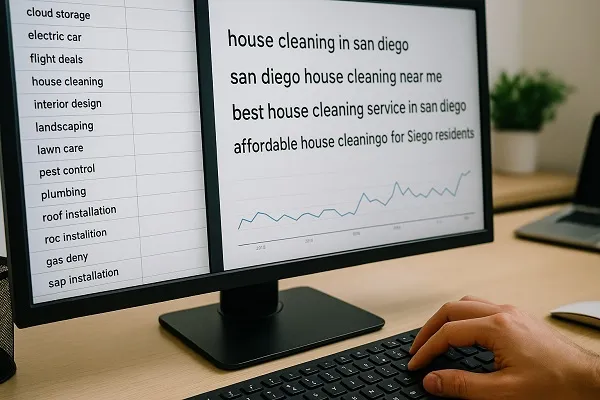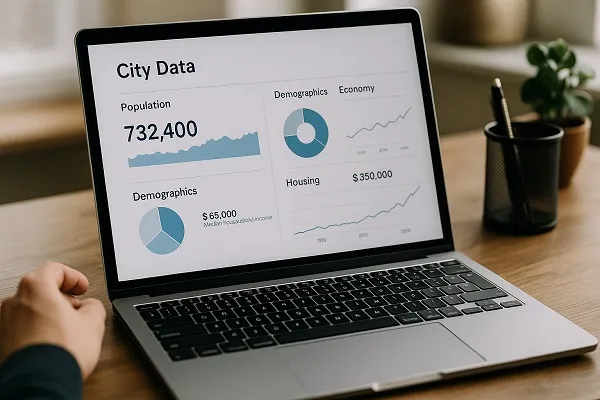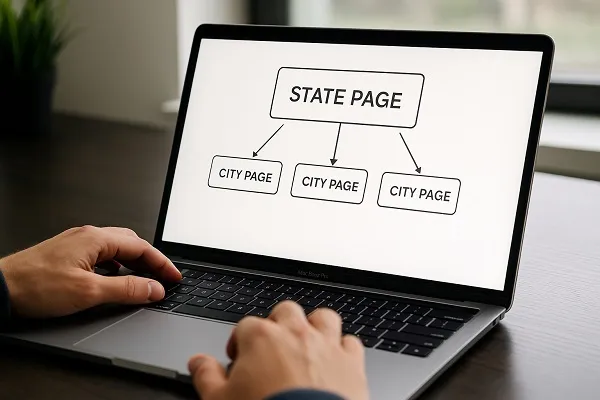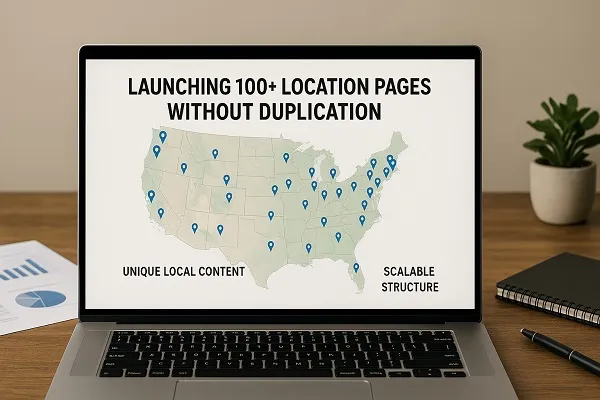Launching 100+ location pages without duplication requires a strategic content plan that balances scalability, SEO value, and user experience. Many businesses attempt to replicate a single template across multiple areas, only to face thin content, cannibalization, indexing issues, or even penalties for duplicate content. Instead, you need a clear framework for local relevance, unique value, and structured content differentiation.
Why Duplicate Location Pages Fail
Google prioritizes unique, value-driven content that offers deeper local relevance. When multiple URLs share the same copy with only the city name swapped, search engines treat the pages as low quality. Duplicate pages also make it hard for users to trust that your business genuinely serves their specific area.
Common issues include:
- Thin or duplicate content
- Low time on page and high bounce rate
- Poor ranking for local keywords
- Wasted crawl budget
- Difficulty being featured in local map packs
- Missed conversion opportunities
Build a Location Page Framework That Scales
A scalable framework prevents duplication and maintains consistent branding without repeating content. Instead of creating every page manually, build a modular system that personalizes each URL using dynamic content.
Core Components of a Scalable Location Page
- Localized keyword targeting
- City-specific or region-specific service details
- Customized introductions
- Geo-targeted calls to action
- Trust-building localized elements such as reviews or photos
Standard Structure to Apply
- Personalized headline and subheadline
- Unique introduction paragraph
- Localized service offerings
- Local proof of trust and credibility
- Location-specific FAQs
- Calls-to-action referencing the city
Research-Driven Local SEO Targeting

Each location page must focus on keywords users within that area actually search for. This requires local intent mapping instead of simply adding a city name before or after the keyword.
Examples of optimized keyword structures:
- [Service] in [City]
- [City] [Service] near me
- Best [Service] provider in [Area]
- Affordable [Service] for [City] residents
Use long-tail variations to reduce competition and increase conversion potential. Incorporate nearby landmarks, neighborhoods, and commonly used local terms to avoid generic SEO phrasing.
Use Dynamic Local Content Blocks
Dynamic blocks allow a single framework to produce unique experiences across hundreds of pages. This prevents repetition while reducing manual editing.
Possible Dynamic Areas
- Custom greeting using local language or slang
- City-specific statistics or pain points
- Seasonal or climate-based messaging
- Nearby location coverage lists
- Local service hours based on region demand
- Travel distances or service radius
Example dynamic sentences:
- We provide fast on-site support for homeowners near [landmark or neighborhood]
- Our team has served [city name] residents since [year]
Integrate Local Photos, Reviews, and Case Studies
User-generated content and social proof offer natural uniqueness. Even a small amount of personalized data significantly differentiates pages.
Useful Content Types
- Photos from local teams, offices, or locations
- Testimonials tagged with city names
- Case studies referencing local clients or industries
- Screenshots of local social media comments
- Google Business Profile embeds
Add Local Data and Statistics

Public sources such as Census, transportation, safety, or housing data can create a unique page identity. When shared responsibly, data can boost topical authority.
Examples of content to include:
- City population size and demographic notes
- Industry or business trends relevant to the service
- Neighborhood lists with common needs
- Local climate or infrastructure challenges
Use data as a supporting element, not filler.
Create Local-Specific Service Modifiers
Instead of repeating generic service descriptions, explain how your offering changes based on local conditions.
Example modifiers:
- Urban vs suburban pricing
- Regional regulations or permits
- Local warranty or service availability
- Distance-based travel fees
- Local industries served
Write Local FAQs for Each Page
Generic FAQs lead to duplication flags. Localized FAQs offer natural keyword inclusion while serving real user concerns.
Example structures:
- How much does [service] cost in [city]?
- Do you offer emergency services for [city]?
- What areas near [city] do you serve?
- What licensing or regulations apply in [city]?
Use Schema Markup for Local SEO
LocalBusiness schema strengthens search engine understanding of each location page. Apply it individually to every location URL.
Best practices:
- Add city-specific NAP (Name, Address, Phone)
- Include service areas
- Use location-based reviews schema
- Add geo coordinates if relevant
Internal Linking Strategy for Multi-Location Sites

Internal linking helps distribute authority and guide crawlers. For more than 100 pages, structure links smartly to avoid orphan pages or cannibalization.
Smart Internal Link Ideas
- Link from state hubs to city pages
- Link between nearby city pages
- Add breadcrumb navigation
- Include footer state and city links
- Link to blog posts about that geographic region
Avoid keyword-stuffed anchor text; keep it natural.
Create Supporting Local Content Clusters
Location pages perform best when supported by related, geo-specific informational content. These can include blogs, case studies, or resource guides.
Examples:
- Cost breakdown articles per region
- Local laws and compliance info
- Region-specific mistakes to avoid
- Seasonal service guides
Leverage AI and Templates Without Copy-Pasting
AI can speed up production but must be carefully supervised. Use it to:
- Generate outline frameworks
- Rewrite portions for tone or clarity
- Help with research summaries
Do not rely on generic AI-generated content for final publication.
Launching 100+ location pages without duplication demands a scalable, data-driven content strategy that blends SEO best practices with authentic personalization. Search engines reward pages that genuinely speak to local audiences, and when each URL contains unique value, rankings and conversions improve naturally. Focus on dynamic components, localized proof, and meaningful internal linking to build authority and expand your digital footprint with confidence.
Content reviewed and published by Parrot Branding Editorial Team.

